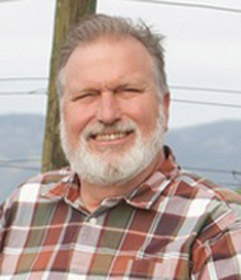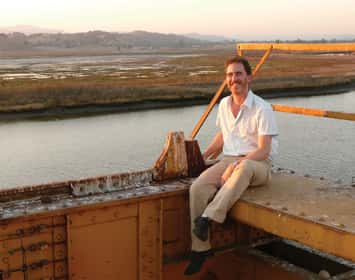“A hundred years after we are gone and forgotten, those who never heard of us will be living with the results of our actions.” —Oliver Wendell Homes
How many times, when people talk about “development,” do you hear the word “happiness?” Right. Almost never. Instead, the words you tend to hear are: “traffic,” “water,” “ugliness,” “sprawl,” “greed,” “blight” and “growth”—as in, "We don’t want more growth."
Nobody, it seems, wants more growth. Except developers. And these days, in the city of Napa, if a developer walks in who happens to be named Keith Rogal, you may want to seek shelter lest a bar fight ensue and you get hit by a chair.
What’s the matter with Keith Rogal?
Oddly enough, when this lightning rod for opposition begins to talk about his projects, the word “happiness” keeps popping up. As in, “The joy isn’t just to make something new that people like—not to make something that just adds to the economy—but to make something that leaves those who were there before feeling honored and happy.”
Who could object to this?
 “I think he’s an element of change,” says Marko Bodor, M.D., medical director of the Queen of the Valley Wellness Center, who’s known Rogal since 1981, when they were undergraduates at Harvard. “And if you’re an element of change, you’re always going to be attacked, even if the change is a good one, because people are afraid of change,” he says.
“I think he’s an element of change,” says Marko Bodor, M.D., medical director of the Queen of the Valley Wellness Center, who’s known Rogal since 1981, when they were undergraduates at Harvard. “And if you’re an element of change, you’re always going to be attacked, even if the change is a good one, because people are afraid of change,” he says.“He’s a thoughtful guy,” says David Graves, 30-year resident of the city of Napa and co-founder of Saintsbury winery in Carneros, “and he’s spent a lot of time thinking about how we can live together in a way that nourishes us.”
“Keith is patient. It’s not like he needs to make a profit for someone by next year. He’s interested in the long run,” says Bodor.
 “He’s sort of a prophet without honor,” adds Graves. “I suppose, if he were to express some of his ideas elsewhere, he’d be greeted as a visionary—as opposed to, ‘Get the hell out of town.’”
“He’s sort of a prophet without honor,” adds Graves. “I suppose, if he were to express some of his ideas elsewhere, he’d be greeted as a visionary—as opposed to, ‘Get the hell out of town.’”New community paradigm
The vision of community development Rogal likes to talk about doesn’t in any way resemble the familiar suburban developments that cropped up after World War II, when America had an urgent need for quick, cheap housing, which residents of pretty areas dread as “sprawl.”
He says that kind of development was a response to a need at the time, and that using the mass production techniques that worked so well in winning the war made sense then, but they don’t work today. “Separating housing from retail, from offices, from schools, from shops, from parks was a quickly conceptualized experiment that had very far-reaching implications,” he says. “As a result of the fundamental changes that occurred in how we organized our places, families came to spend ever-greater amounts of time in their cars driving to and from everywhere.”
Now, our roads are clogged. We can’t take any more traffic. We don’t need—and shouldn’t have—more of that kind of development. What we do need, he explains, is something new, which is actually very old.
Looking back
As a young boy, traveling through the great cities in Europe, Asia and Central and South America with his parents (his father was in the high-end international travel business), Rogal learned to see the difference between how people lived around the globe and how people lived in the American suburbs. He says the suburban model deprives people of the casual interaction you get in a village or European cities, like Amsterdam, say, where far more people walk and bike. It isolates them within the home and forces a dependency on the automobile. “The average suburban household generates 10 to 12 car trips per day,” he says, “because you just can’t do anything without getting into your car. People don’t walk because the streets aren’t organized for walking. So a host of pathologies emerge.”
At Harvard, he followed his interest in architectural history and landscape and urban design. After graduation, he began to focus his efforts on planning and development, from the perspective of what works for neighborhoods. “I did this project in a Boston neighborhood called Roxbury,” he says, “which was sort of Boston’s Harlem at that point—very depressed—and the challenge was to restore a historic building and construct contextual new units, attached, to adapt it to accommodate both market-rate and low-income housing.” He was excited by the experience, which showed him the potential of mixed-use development and the value of shaping a development plan with community input.
He chose the Yale School of Management for his graduate work, rather than a traditional business school, because it addressed a wide range of interest groups. “It included private sector people coming from investment banks, nonprofit people coming from organizations like Save the Children and a wide range charitable organizations from the public sector,” he says. “So I’d be sitting in an economics class next to a tenants’ rights activist, or with a food relief organization on one side and a guy from Goldman Sachs on the other side.”
They were all given the tools—market analysis, statistics, political risk assessment, finance—to learn how the economy works. “The program equipped the public and nonprofit groups, which had less exposure to those tools,” he says, “and expanded the vision of those in the private sector, whose exclusive mindset had been limiting their perspective.” At Yale, he was able to develop his skills in assessing the complexities of community needs, which, after working in Hawaii and in cities on both U.S. coasts, he wanted to apply in Napa.
In 1997, he was drawn to Napa by a blighted, 27-acre RV park and boat storage yard in Carneros, with a vision to recycle the property in a manner that would serve both visitors and locals, and that would feel right for Carneros. Keith Rogal found himself facing howls of opposition. (See “The Triumph of the Test of Time,” and “One Down, Two to Go,” below.)
Development in Napa Valley? No, no, no!
The beauty and culture of Napa Valley and its reputation as a world famous wine, food and lifestyle destination has been legally guarded since 1968 by the Napa Valley Agricultural Preserve, an ordinance forged by iconic landowners and put in place by county supervisors, who’d seen the result of rampant development elsewhere. As a result, at the mere utterance of the word “development” in Napa, people’s ears go back.
But not all developments are alike, and not all developers are alike. A few developers have managed to create beautiful projects in the city of Napa, with full community support. But Rogal’s plans draw fire. Why is that?
 Bill Dodd, Napa County Supervisor, says it’s not so much the man, but the nature of the projects. “If you take a look at the premier developers in Napa—Harry Price, Mike DeSimoni and Todd Zapolski—they’ve all had projects that were visionary and at the same time were welcomed by the community at large. Whereas Rogal has had key pieces of property, with visionary plans, the enthusiasm for which,” he says carefully, “wasn’t shared by everyone.”
Bill Dodd, Napa County Supervisor, says it’s not so much the man, but the nature of the projects. “If you take a look at the premier developers in Napa—Harry Price, Mike DeSimoni and Todd Zapolski—they’ve all had projects that were visionary and at the same time were welcomed by the community at large. Whereas Rogal has had key pieces of property, with visionary plans, the enthusiasm for which,” he says carefully, “wasn’t shared by everyone.”Dodd goes on to say that the Price, DeSimoni and Zapolski developments all had to do with restoring the city of Napa riverfront and Town Center and are all improvements designed to help make the city of Napa a destination on its own. Keith Rogal’s projects, in the county, are about reclaiming compromised land and creating livable communities.
Napa Pipe
Napa County has been sued twice by an out-of-town, private citizen-watchdog attorney,intent on forcing the county to fulfill his notions of its state-imposed obligation to provide sufficient affordable housing. The county is willing, but the problem is, where to put it? Neighbors object to new housing developments in their scenic valley cities. The Ag Preserve forbids housing development on agricultural land. And, in general, nobody wants to see Napa Valley’s character ruined by “sprawl.” In addition to being ugly, that would be bad for business, because people come to Napa Valley for the beauty as well as the wine.
“In fact,” says Graves, who, in addition to running his winery, sits on the board of Friends of the River, “the economy of Napa County is growing. There’s a bigger footprint of hospitality—restaurants and hotels. And those sectors employ a lot of folks who don’t get paid a lot.” So there’s a need for decent housing for those low-wage people who, when they don’t live close to where they work, spend a lot of time on the highways.
“A lot of people think the traffic we have now is because the county has grown or the city has grown,” echoes Supervisor Dodd. “But the reality is that most of the traffic we have at peak times is all our workers who can’t afford to live here, so they’re commuting in from Solano County. It’s the 29,000 commuters who are causing the traffic problems in Napa Valley.”
 Solution…with a catch
Solution…with a catch
Rogal’s Napa Pipe project, on 154 acres of abandoned industrial land bordering the edge of the city of Napa, has been in the works for a long time, has undergone many revisions and is now edging toward final approval. “The joke around here,” says Dodd, “is that, if someone had been pregnant at the time his application first came in, the kid would be in third grade right now!”
The project, now supported by the city and county and even by environmentalists such as the Greenbelt Alliance, and rated “Gold” by the U.S. Green Building Council, was, when the original plans were first unveiled, greeted by cries of shock. The scale of it! More than 3,000 residences! It’s like a whole city! Buildings up to seven stories high! This just isn’t what’s done here! It was like an urban Godzilla, crunching toward Napa. This wasn’t just a game changer—it was a game wrecker!
“In Napa County, we’ve never done development like this,” says Dodd. “We’ve been recognized as a leader in agriculture and creating open space, and this was something out of the blue, brought on by the State Department of Housing and Conservation.” Sure, the county was required to create housing. And it needed to reduce commuter traffic. And developing this industrial area would not interfere with open space or aesthetics. But…this?
Rogal’s grand design
“People react to the threat of housing developments often with the fear that it’s going to produce more traffic,” Rogal counters. “The issue isn’t more people, and its not more homes. It’s the way we’re organizing our land.”
In 1992, he took a job with a research and development consortium, funded by the U.S. Department of Energy, General Electric, Kohler and other leading companies in the housing industry, that was working to improve the processes of building. During that time, he also attended the Congress for the New Urbanism (CNU) conference in Alexandria, Va., at which the CNU Charter was developed and signed by attendees. The conference galvanized Rogal’s vision of how development patterns in America could be changed, neighborhood-by-neighborhood.
Rogal’s signature is on the CNU charter, from which he recites, “The Congress views the disinvestment in cities, placeless sprawl and increasing separation by race and income environmental deterioration, loss of agricultural land and wilderness as one interrelated community challenge. We stand for the restoration of existing urban centers and towns and metropolitan regions and the reconfiguration of sprawling suburbs and the conservation of neighborhoods.”
The principles of the CNU charter were among the guiding planning principles he brought to Napa Pipe.
Another principle he was guided by was that of listening. “For the first year, people said, ‘What’s your plan? What’s your vision?’ And I said, ‘You know, it’s really a big place, it could be a lot of things: What’s your vision?’”
After spending a year listening to people, he concluded that what people all seemed to be wanting was community. “I’d talked to young single moms, young couples starting their lives, single professionals, empty nesters and people whose lives were more simple, financially. We talked about the river, about walking and about being able to see friends—and not one person talked about anything that sounded like a single-family detached house.” Nobody seemed to be longing for the suburbs.
His environmental principles are expressed in the design plans he created over the last seven years, which feature LEED-inspired energy and water design, including permeable surfaces for parking lots and walkways, and in the choice of the property itself. He says he believes in focusing on and reclaiming properties that have become blighted, obsolete or contaminated, and for his developments to be places for healthy social values where people can be happy.
Paradox and progress
“We want to preserve the character of Napa Valley, the scenery, open spaces—and development always threatens that,” says Bodor, “But the kind of development Keith talks about could actually help that.”
Despite the initial shock, the city and county officials, knowing how important it is to get more housing in the county—without ruining the character that makes it famous—have worked hard to make the project happen. Now scaled back to 975 housing units and adding a Costco and a school, the project is moving forward.
“Essentially, it was Keith Caldwell and myself representing the county and Jill Techel and Juliana Inman representing the city,” says Dodd, “We were the negotiating team, and we put together a far-reaching agreement that essentially will ask the voters to bring that property into the city. If it’s approved by the voters, the county will give the city all the revenues from the property—the sales tax, the TOT tax, and then we’ll do a sharing of the property tax. In exchange for that, the county will receive from the city 80 percent of its housing needs for as long as the Ag Preserve is in full force and effect.” The benefits go both ways.
Nobody said it’s easy
“This work is really hard and very slow,” says Rogal. “Frankly, there are other ways to make money in real estate that are a lot easier and quicker. But they don’t have the same reward. So while we all want to make a good return on our investment, for me personally, the joy is to sit in a place like Carneros and enjoy a meal with people who live there or are visiting, and to see them happy for the place we’ve created. It’s especially gratifying to see the people working there are happy.”
There’s that word again. Time will tell if future residents of Napa Pipe enjoy the happiness of community Rogal has envisioned. But for now, there’s a feeling of relief that the city, county and developer have managed to wrestle down their differences and forge a collaboration that will provide a solution to the county’s very serious problem.
Dodd, who’s worked hard for this project from the start, summarized the effort in more pragmatic terms: “It’s just a beautiful thing that gets the county out of harm’s way from the state of California and attorneys, which we’ve been fighting for 14 years over its requirement for housing, at great expense to the taxpayers.”
As for Rogal’s third project—the redevelopment of Copia—where the game is the legacy of Mondavi and the character of the city of Napa, happiness seems far away—stay tuned!
 The Triumph of the Test of Time
The Triumph of the Test of Time
The Carneros Inn, which opened for business in 2003, was this year voted one of the 25 most romantic getaways by Travel and Leisure, and was described in the Conde Nast “Gold List 2014” as “breathtakingly beautiful.” This reclamation project has won awards from the American Institute of Architects and the Congress of New Urbanism and features 85 guest cottages and suites plus private home rentals, a private residence option, three restaurants, pools and award-winning spa facilities—all surrounded by gorgeous views of Napa Valley.
Now in its 11th year, the Carneros Inn has stood the test of time, and people who rallieed against it early on can now occasionally be seen happily lunching at the Boon Fly Café, says Rogal. Supervisor Bill Dodd also praises it. “I like it,” he says. “There are still some challenges with water systems, but it’s a fine example of modern Wine Country hospitality.”
One Down, Two to Go
Rogal’s first project, undertaken with his partners Richard Walsh, Caspar Mol and Nick Monroe, and completed in 2003, turned an eyesore into the award-winning Carneros Inn.
His second project, also with his partners Walsh and Mol, and now in the final stages of approval, is slated to transform a large-scale mixed-use brownfield reclamation called Napa Pipe (for the industry that’s no longer there) into high-density community living.
His third project, and first in the city of Napa proper, is the hotly contested Copia Redevelopment Project. Because of many uncertainties, including zoning and what’s actually to be allowed in the building itself, this project is in the very early—can we say bruising?—stages of a master planning process. The Copia planning efforts have been directed by the ACA Financial Guaranty with Rogal leading several local engineering and design firms as a consultant, on behalf of ACA and the Copia Liquidating Trust.




